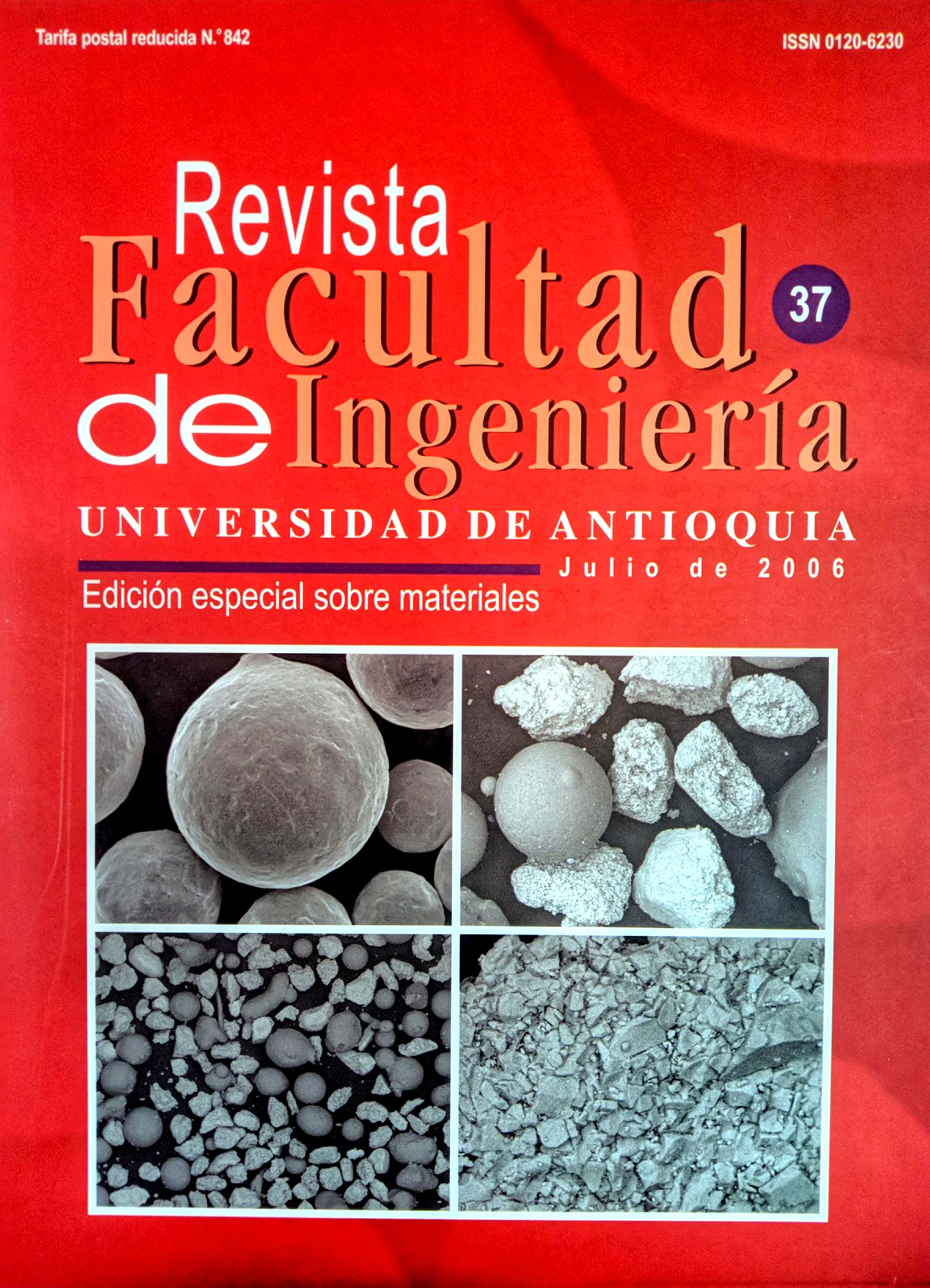La importancia de las curvas RID y P-h en los estudios de capas TiN depositadas sobre aceros M2 y 304L
DOI:
https://doi.org/10.17533/udea.redin.343444Palabras clave:
propiedades mecánicas, capas finas, indentación, dureza, TiN, PAPVDResumen
En este trabajo se realizó un estudio de la dureza de capas TiN aplicadas mediante PAPVD depositadas sobre acero M2 e inoxidable 304L. Esto se hizo utilizando un equipo de indentación con censado de desplazamiento y equipos de micro y macrodureza convencionales. Los patrones de agrietamiento dejados en la impresión se correlacionaron con estas propiedades. Se obtuvo información importante de las curvas P-h/t (Carga-desplazamiento/espesor de la capa), llamadas curvas de desplazamiento relativo del indentador (curvas RID), y de las curvas P-h . Ambas curves mostraron ser de gran importancia en el entendimiento del comportamiento mecánico de los sistemas estudiados.
Descargas
Citas
C. Fisher, “Nanoindentation,” Springer, 2nd ed., 2004.
S. V. Hainsworth, M. R. McGurk, T. F. Page. “The effect of coating cracking on the indentation response of thin hard-coated systems”. Surf. Coat. Tech. Vol. 102. 1998. 97-107. DOI: https://doi.org/10.1016/S0257-8972(97)00683-X
A. M. Korsunsky, M. R. McGurk, S. J. Bull, T. F. Page. “On the hardness of coated systems”. Surf. Coat. Tech. Vol. 99. 1998. pp.171-183. DOI: https://doi.org/10.1016/S0257-8972(97)00522-7
M. R. McGurk, T. F. Page. “Using the P-δ2 analysis to deconvolute the nanoindentation response of hard-coated systems”. J. Mater. Res. Vol. 14. 1999. pp. 2283-2295. DOI: https://doi.org/10.1557/JMR.1999.0305
J. R. Tuck, A. M. Korsunsky, S. J. Bull, R. I. Davidson. “On the application of the work-of-indentation approach to depth-sensing indentation experiments in coated systems”. Surf. Coat. Tech. Vol. 137. 2001. pp. 217-224. DOI: https://doi.org/10.1016/S0257-8972(00)01063-X
J. R. Tuck, A. M. Korsunsky, D. G. Bhatc, S. J. Bull. “Indentation hardness evaluation of cathodic arc deposited thin hard coatings”. Surf. Coat. Tech. Vol. 139. 2001. pp 63-74. DOI: https://doi.org/10.1016/S0257-8972(00)01116-6
J. Loubet, J. Georges, G. Meille, In: Blau P. J:, Lawn B. R. (eds.). Microindentation Techniques in Materials science an Engineering ASTM STP 889. American Society for testing and Materials.Philadelphia. PA. 1986. pp. 72-89. DOI: https://doi.org/10.1520/STP32952S
A. Bolshakov, G. M. Pharr. “Influences of pile up on the measurement of mechanical properties by load and depth sensing indentation techniques”. J. Mater. Res. Vol. 13 1988. pp. 1049-1058. DOI: https://doi.org/10.1557/JMR.1998.0146
J. M. Meza, Jr. Franco., J. M. Vélez. “Calibration of nanoindentation equipment by means of Linear Method”. In preparation.
K. D. Bouzakis, N. Michaidilis, S. Hadjiyiannis, G. Erkens. “The effect of specimen roughness and indenter tip geometry on the determination accuracy of thin hard coatings stress-strain laws by nanoindentation”. Mater. Charact. Vol. 49. 2003. pp. 149-156. DOI: https://doi.org/10.1016/S1044-5803(02)00361-3
A. Leyland, A. Matthews, “On the significance of the H/E ratio in wear control: a nonocomposite coating approach to optimised tribological behaviour”. Wear Vol. 246. 2000. pp. 1-11. DOI: https://doi.org/10.1016/S0043-1648(00)00488-9
R. Yu Lo, D. Bogy. “Compensating for elastic deformation of the indenter in hardness test of very hard materials”. J. Mater. Res. Vol. 14. 1999. pp. 2276-2282. DOI: https://doi.org/10.1557/JMR.1999.0304
W. C. Oliver, G. M. Pharr. “An improved technique for determining hardness and elastic modulus using load and displacement sensing indentation experiments”. J. Mater. Res. Vol. 7. 1992. pp. 1564-83. DOI: https://doi.org/10.1557/JMR.1992.1564
X. Cay, H. Bangert. “Hardness measurements of thin films-determining the critical ratio of depth to thickness using FEM”. Thin Solid Films Vol. 264. 1995. pp. 59-71. DOI: https://doi.org/10.1016/0040-6090(95)06569-5
S. Bhowmick, A. Kale, V. Jayaram, S. K. Biswas. “Contact damage in TiN coating on steel”. Thin Solid Films. Vol. 436. 2003. pp. 250-258. DOI: https://doi.org/10.1016/S0040-6090(03)00598-4
J. M. Meza. “Applied indentation techniques to asses mechanical properties of TiN films”. MsC thesis. National University of Colombia. January. 2004.
A. G. Evans, E. Charles, “Fracture Toughness determination by indentation”. J. Amer Ceram. Soc. Vol. 59. 1976. pp. 371-372. DOI: https://doi.org/10.1111/j.1151-2916.1976.tb10991.x
Descargas
Publicado
Cómo citar
Número
Sección
Licencia
Los artículos disponibles en la Revista Facultad de Ingeniería, Universidad de Antioquia están bajo la licencia Creative Commons Attribution BY-NC-SA 4.0.
Eres libre de:
Compartir — copiar y redistribuir el material en cualquier medio o formato
Adaptar : remezclar, transformar y construir sobre el material.
Bajo los siguientes términos:
Reconocimiento : debe otorgar el crédito correspondiente , proporcionar un enlace a la licencia e indicar si se realizaron cambios . Puede hacerlo de cualquier manera razonable, pero no de ninguna manera que sugiera que el licenciante lo respalda a usted o su uso.
No comercial : no puede utilizar el material con fines comerciales .
Compartir igual : si remezcla, transforma o construye a partir del material, debe distribuir sus contribuciones bajo la misma licencia que el original.
El material publicado por la revista puede ser distribuido, copiado y exhibido por terceros si se dan los respectivos créditos a la revista, sin ningún costo. No se puede obtener ningún beneficio comercial y las obras derivadas tienen que estar bajo los mismos términos de licencia que el trabajo original.










 Twitter
Twitter